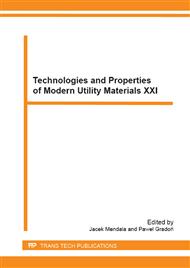p.25
p.29
p.35
p.39
p.45
p.49
p.53
p.59
p.63
The Correlation between the Surface Geometry of Tested Materials and the Shape of Lubricant Drop
Abstract:
In manufacturing of air compressors, piston engines and guides, lubricants are used to result in formation of a continuous oil film that separates the friction surfaces. The continuity of this film within the entire operating range of the friction pair, from starting to steady state, is the guarantee of proper operation. The surface geometry of friction elements plays significant role in maintaining continuity of the oil film. The widely used method for obtaining proper surface condition of the structural components of piston systems is the honing process. This method consists of shaping the microgeometry of the surface of friction pair elements by material removal processing methods (turning, grinding, laser processing) to prevent rapid spreading of lubricant, and thus to prevent breaking of the oil film. In case of Al-MMCs using for manufacturing the parts of machines working under friction with lubrication conditions the shaping of their working surface by honing is limited by the machining efficiency. The investigations on surface geometry of elements made of composites including ceramic reinforcement revealed that presence of reinforcement particles on the working surface bring the changes which can be used for shaping the correct oil film. The investigations presented in this article can be used for evaluation of lubricant propagation process on the composite material surface.
Info:
Periodical:
Pages:
45-48
Citation:
Online since:
December 2013
Authors:
Price:
Сopyright:
© 2014 Trans Tech Publications Ltd. All Rights Reserved
Share:
Citation:


